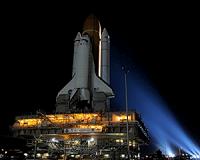 |
Birmingham AL (SPX) Apr 08, 2011 Astronauts anticipate more trips to the moon and manned missions to Mars. But exposure to cosmic radiation outside the Earth's magnetic field could be detrimental to their arteries, according to a study by University of Alabama at Birmingham researchers published April 6, 2011, online in the journal Radiation Research. Using an animal model, researchers assessed the affect of iron ion radiation commonly found in outer space to see if exposures promoted the development of atherosclerosis, as terrestrial sources of radiation are known to do. They observed that cosmic radiation accelerated the development of atherosclerosis, independent of the cholesterol levels or circulating white blood cells of the mice. It also worsened existing atherosclerotic lesions. "It's well known that prolonged exposure to radiation sources here on Earth, including those used in cancer treatment, excessive occupational exposure and atomic bombs, are associated with an increased risk for atherosclerosis," said Dennis Kucik, M.D., Ph.D., associate professor in the UAB Department of Pathology. "But cosmic radiation is very different from X-rays and other radiation found on Earth. The radiation risks of deep-space travel are difficult to predict, largely because so few people have been exposed." Accelerated ions in cosmic radiation interact differently with objects and people, Kucik said. X-rays can be blocked by lead shields; however, cosmic radiation ions can become more dangerous when they interact with metals, generating secondary particles that also may have biological effects. Although it is possible to use other materials to shield against ion radiation, incorporating these into spacesuits presents significant challenges. The only people who have been exposed to high levels of cosmic radiation are the 24 astronauts who have been to the moon as part of NASA's Apollo missions in the late 1960s and early 1970s. Kucik said because many people have early atherosclerosis - whether they travel in space or not - they could not draw any conclusions from the small number of astronauts who have been outside the Earth's magnetic field. And, he added, even if they could, with so few people it would be impossible to perform a relevant epidemiological study Instead, Kucik and his colleagues examined atherosclerosis development in mice following targeted exposure to a particle beam of high-velocity iron ions - similar to those found in space - produced by scientists at Brookhaven National Laboratory in New York. They analyzed the mice at 13 and 40 weeks afterward to assess the development of atherosclerosis in the aorta and carotid arteries. They concluded there was involvement of components in the arterial wall in the biological response to radiation injury. "At 13 weeks it was surprising and quite remarkable that we already could see permanent damage - an irreversible thickening of the artery wall where it had been exposed to radiation," said co-author Janusz Kabarowski, Ph.D., assistant professor in the UAB Department of Microbiology. "The irradiation had no significant effect on the frequency of circulating immune and inflammatory white blood cells or plasma lipid profile." Knowing the effects of cosmic radiation on the heart health of deep-space astronauts will help meet the unique challenges of treatment and prevention posed by missions of long duration, Kabarowski said. "Our future research will look at the mechanisms causing the damage, and we will try to find a way to target those mechanisms to correct the damage or prevent it altogether." Kucik said the team's findings also may inform cancer treatment. Newer proton radiation therapies can be targeted to stop and deposit all of their energy in a tumor, much like iron ions from space stop in the body. "No one knows the atherosclerotic risk of this therapy," Kucik said. "Anything we learn through these studies on deep-space travel will be useful for cancer patients." Kucik and Kabarowski's research was supported by a grant from the National Space Biomedical Research Institute through NASA. Co-authors on the paper are Tao Yu, Kiran Gupta, Xing Wu and Saman Khaled from the UAB Department of Pathology; Brian Parks, Shaohua Yu and Roshni Srivastava from the UAB Department of Microbiology; and Polly Chang from SRI International in Menlo Park, Calif.
Share This Article With Planet Earth
Related Links University of Alabama at Birmingham Space Tourism, Space Transport and Space Exploration News
 Witnesses Say Future Of NASA Human Space Flight Is Uncertain
Witnesses Say Future Of NASA Human Space Flight Is UncertainWashington DC (SPX) Apr 01, 2011 today, in a hearing of the Subcommittee on Space and Aeronautics, witnesses expressed serious concern about the lack of clear focus by the Administration on NASA's transition from the Space Shuttle program toward development of the Space Launch System (SLS) and Multi Purpose Crew Vehicle (MPCV). These vital components of NASA's human space flight program were outlined as top priorities in the NA ... read more |
|
| The content herein, unless otherwise known to be public domain, are Copyright 1995-2010 - SpaceDaily. AFP and UPI Wire Stories are copyright Agence France-Presse and United Press International. ESA Portal Reports are copyright European Space Agency. All NASA sourced material is public domain. Additional copyrights may apply in whole or part to other bona fide parties. Advertising does not imply endorsement,agreement or approval of any opinions, statements or information provided by SpaceDaily on any Web page published or hosted by SpaceDaily. Privacy Statement |